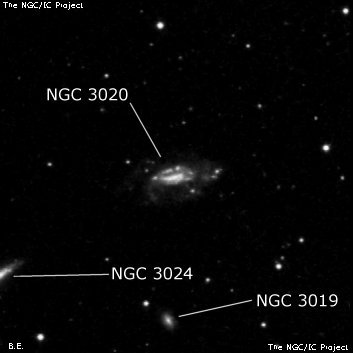
William Herschel discovered NGC 3020 = H III-51 = h646 = h642 on 19 Mar 1784 (sweep 177) and recorded "Two [along with NGC 3024], both resolvable and eF. The preceding is the largest and they are about 6 or 7' distant from each other. Position about 20° np-sf 6 or 7' distant. I saw them better with 240 than 157. They require some attention before they are well seen." His single position is ~1.0 min of RA too far east.
John Herschel made three observations under h646 and measured an accurate position, but on a 4th sweep he made an error recording the RA 1.0 min too far west and claimed a "nova" under h642. Dreyer correctly equated the H and h designations in the NGC.
300/350mm - 13.1" (4/29/84): fairly faint, moderately large, diffuse, elongated ~E-W.
400/500mm - 17.5" (3/23/85): brightest and largest in the NGC 3020 group, elongated WNW-ESE, brighter core but no nucleus, diffuse halo. Nearby are NGC 3019 4.0' S, NGC 3024 5.4' SE.
600/800mm - 24" (4/20/14): at 280x appeared fairly bright, fairly large, oval 5:3 WNW-ESE, 1.7'x1.0', large elongated core appears to be a bar, mottled appearance. Spiral structure was highly suspected in the halo. Largest and brightest in a quintet with NGC 3019 4' S, NGC 3024 5.5' SE, NGC 3016 8' SSW and CGCG 063-075 11' SW. NGC 3020 and 3024 are a physical pair (z = .004), while the other three galaxies are in the backgroud at z = .03.
Notes by Steve Gottlieb